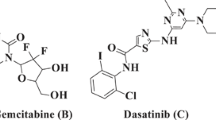Abstract
A series of novel 3,5-disubstituted 1,3,4-oxadiazole-2-thione derivatives (1e, 2e, 3e, 4e, and 5e) have been synthesized from different substituted aromatic acids. The structure determination of these compounds have been made on the basis of IR, 1H NMR, and Elemental analysis. The effect of all the compounds on tumor growth inhibition was evaluated by studying the parameters—tumor volume, percentage of the tumor cell count (viable and nonviable), hematological values, and the mean survival status of the treated animals on eight groups of Swiss albino mice. Compounds were given at the dose of 50 mg/kg body weight intraperitoneally and all exhibited the significant (P < 0.001) anticancer activity compared to control. 5-Fluorouracil was used as a standard drug (20 mg/kg body weight i.p.) in the study. All the compounds demonstrated a prominent anticancer activity. The study supported the derivatives of oxadiazoles for the development as potent anticancer molecules.


Similar content being viewed by others
References
Al-Harbi MM, Qureshi S, Raza M, Ahmed MM, Giangreco AB, Shah AH (1995) Influence of anethol treatment on the tumor induced by Ehrlich ascites carcinoma cells in paw of Swiss albino mice. Eur J Cancer Prev 4:307–318
Cehn C, Senanyake CH, Bill TJ, Larsen RD, Veshoeven TR, Reider PJ (1994) A practical synthesis of a COX-2-specific inhibitor. J Org Chem 59:3737–3743
Diana GD, Volkots DL, Nitz TJ, Baily TR, Long MA, Vesico N, Aldous A, Pevear DC, Dukto FJ (1994) 3-Pyridines as replacements for an isoxazole ring: the antirhinoviral activity of pyridine analogues related to disoxaril. J Med Chem 37:2421–2425
Giri SH, Singh LD, Yadav S (1976) Studies on some antifungal transition metal chelates of N-(5-phenyl-1,3,4-thiadiazol-2-yl) dithiocarbamic acid. Agric Biol Chem 40:17–21
Husain MI, Kumar A, Srivastava RC (1986) Synthesis and pharmacological evaluation of 1,3,4-oxadiazole bearing bis(heterocycle) derivatives as anti-inflammatory and analgesic agents. Current Sci 55:644–646
Kadi AA, El-Brollosy NR, Al-Deeb OA, Habib EE, Ibrahim TM, El-Emam AA (2007) A synthesis, antimicrobial, and anti-inflammatory activities of novel 2-(1-adamantyl)-5-substituted-1,3,4-oxadiazoles and 2-(1-adamantylamino)-5-substituted-1,3,4-thiadiazoles. Eur J Med Chem 42:235–242
Kucukguzel SG, Rollas S, Erdeniz H, Kiraz M (1999) Synthesis and antimycobacterial activity of some coupling products from 4-aminobenzoic acid hydrazones. Eur J Med Chem 99:153–160
Ladduwahetty T, Baker R, Cascieri MA, Chambers MS, Haworth K, Keown LE, Maclntyre DE, Metzer JM, Owen S, Rycroft W, Sadowski S, Seward EM, Shepheared SL, Swain CJ, Tattersal FD, Watt AP, Willamson DW, Hargreaves RJ (1996) 3-Benzyloxy-2-phenylpiperidine NK1 antagonists: the influence of alpha methyl substitution. J Med Chem 39:2901–2907
Latha PG, Panikkar KR (1998) Inhibition of chemical carcinogenesis in mice by Ixora coccinea flowers. Cancer Lett 130:197–202
Loetchutinat C, Chau F, Mankhetkorn S (2003) Synthesis and evaluation of 5-aryl-3-(4-hydroxyphenyl)-1,3,4-oxadiazole-2-(3H)-thiones as P-glycoprotein inhibitors. Chem Pharm Bull 51:728–730
Mamolo MG, Zampieri D, Vio L, Fermeglia M, Ferrone M, Pricl S, Scialinoc G, Banfi E (2005) Antimycobacterial activity of new 3-substituted 5-(pyridin-4-yl)-3H-1,3,4-oxadiazol-2-one and 2-thione derivatives. Preliminary molecular modeling investigations. Bioorg Med Chem 13:3797–3809
Misra HK (1983) Synthesis of some new substituted 1,3,4-oxadiazoles as potential insecticidal, antibacterial and anti-acetylcholine esterase agents. Arch Pharm 316:487–493
Omar FA, Mahfouz NN, Rehman MA (1996) Design, synthesis and antiinflammatory activity of some 1,3,4-oxadiazole derivatives. Eur J Med Chem 31:819–825
Phillips OA, Udo EE, Abdel-Hamid ME, Varghese R (2009) Synthesis and antibacterial activity of novel 5-(4-methyl-1H-1,2,3-triazole) methyl oxazolidinones. Eur J Med Chem 44:3217–3227
Qureshi S, Al-Harbi MM, Ahmed MM, Raza M, Giangreco AB, Shah AH (1993) Influence of anethole treatment on the tumour induced by Ehrlich ascites carcinoma cells in paw of Swiss albino mice. Cancer Chemother Pharmacol 33:130–138
Qureshi S, Al-Shabanah OA, Al-Harbi MM, Al-Bekairi AM, Raza M (2001) Boric acid enhances in vivo Ehrlich ascites carcinoma cellproliferation in Swiss albino mice. Toxicology 165:1–11
Raman K, Singh KH, Salzman SK, Parmar SS (1993) Synthesis and antimicrobial activity of some 1,3,4-oxadiazole derivatives. J Pharm Sci 82:167–169
Sahin G, Palaska E, Kelicen P, Demirdamar R, Altinok G (2001) Synthesis and antimicrobial activity of some 1,3,4-oxadiazole derivatives. Arzneim Forsch/Drugs Res 51:478–484
Sengupta P, Dash DK, Yeligar VC, Murugesh K, Rajalingam D, Singh J, Maity TK (2008) Evaluation of anticancer activity of some 1,3,4-oxadiazole derivatives. Indian J Chem 47:460–462
Swan CJ, Baker R, Kneen C, Moseley J, Saunders J, Seward EM, Stevenson G, Beer M, Stanton J, Walting K (1991) Synthesis and cannabinoid activity of 1-substituted indole-3-oxadiazole derivatives: novel agonists for the CB1 receptor. J Med Chem 34:14–17
Trully WR, Gardner CR, Gillespie RJ, Westwood R (1991) 2-(oxadiazolyl)- and 2-(thiazolyl)imidazo[1,2-a]pyrimidines as agonists and inverse agonists at benzodiazepine receptors. J Med Chem 34:2058–2060
Zarafoenetis CJD (1969) Methods for the examination of the blood. In: Kolmer JA, Spaulding EH, Robinson HW (eds) Approved laboratory techniques. Appleton-Century-Crofts, New York, pp 39–126
Acknowledgments
One of the authors is thankful to the All India Council for Technical Education (AICTE) and University Grand Commission (UGC) for providing financial support for the completion of this project and the authority of Jadavpur University for providing the laboratory facility.
Author information
Authors and Affiliations
Corresponding author
Rights and permissions
About this article
Cite this article
Dash, S., Kumar, B.A., Singh, J. et al. Synthesis of some novel 3,5-disubstituted 1,3,4-oxadiazole derivatives and anticancer activity on EAC animal model. Med Chem Res 20, 1206–1213 (2011). https://doi.org/10.1007/s00044-010-9455-6
Received:
Accepted:
Published:
Issue Date:
DOI: https://doi.org/10.1007/s00044-010-9455-6




